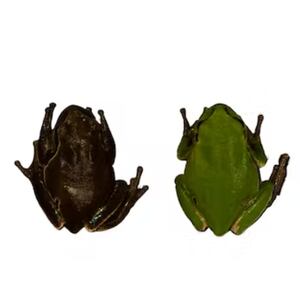Roughly 350,000 people evacuated during the 1986 disaster at the Chernobyl Nuclear Power Plant in 1986, leaving their lives and belongings behind to flee the worst nuclear disaster in history. Facets of residents’ lives left behind but often unmentioned are their pets, which evacuees were forbidden to retrieve. Despite the high levels of radiation in the Chernobyl Exclusion Zone, many of these animals survived, and their descendants can be found in and around the region today.
Prancer, one of these dogs, got her name from a dance she does whenever she greets Tim Mousseau’s research team. Mousseau, a biology researcher at the University of South Carolina, has studied the effects of radiation on living organisms in sites like Chernobyl and Fukushima for decades. Usually, however, his subjects are a lot smaller, potentially a result of the extremely harsh conditions created by nuclear radiation.
“These are dogs. You can't help but love them and develop relationships with them,” he told The Daily Beast. “We think about bringing them home with us every time we go.”
Even in conditions that drastically limit their lifespan—Mousseau said most of the Chernobyl canines only live to three—the dogs have found a way to thrive. Locals and an increasing number of dark tourists feed the dogs resulting in a surge in the canines’ population that have driven nonprofits and researchers to regularly provide veterinary care, and spay and neuter as many dogs as they can. Over the course of three years, Mousseau has collected hundreds of blood samples from the dogs as part of these efforts.
The dogs’ blood contained an incredibly rare opportunity: a glimpse into how life prevails even under unnaturally harsh conditions. When Mousseau came to National Human Genome Research Institute geneticist Elaine Ostrander to analyze nearly 300 of these blood samples, she wasn’t about to let the chance slip by.
“I said, ‘Me, me, me, me, me,’” she told The Daily Beast. “It's such an extraordinary opportunity, and it does have implications for human health and biology.”
Mousseau and Ostrander’s team published genetic sequencing results from the Chernobyl dogs on March 3 in the journal Science Advances. According to the authors, the study represents “the first genetic analysis of domestic dogs affected by a nuclear disaster,” providing a baseline to measure the impact of prolonged radiation exposure on an animal’s genetic health.
The radiation in Chernobyl City and near the power plant breaks the pooches’ DNA strands. Their cells try to repair it, but errors often occur. DNA gets deleted, spontaneously added, or switched around willy-nilly. Understanding how the Chernobyl dogs are able to survive in spite of this constant assault could inform a field like cancer treatment, since incorrectly repaired DNA is often found in cancer cells, Ostrander said.
“These dogs are surviving generation after generation, they’re fertile, they're carrying out all their bodily functions, and they even have behavioral relationships with people in the area—they're doing all the dog stuff they're supposed to be doing,” Ostrander said. “What's allowed them to overcome [the radiation]? From the viewpoint of someone at the National Institutes of Health, we really care about that.”
During visits to the Exclusion Zone, Mousseau and others have noticed dogs living both in Chernobyl City and in and around the nuclear power plant—the latter of which is striking, given the area’s high, ongoing levels of radioactive contamination. But it was not known how closely these two populations were related, and additionally, how genetically similar they were to dogs in a nearby village.
As it turned out, both were genetically distinct—from a nearby village dog population and from each other. The next step, which the researchers are already diving into, is to start to isolate the genetic regions that make the Chernobyl dogs different. It’s all speculation at the moment, but Mousseau and Ostrandar both have theories.
For his part, Mousseau has studied an assortment of flora and fauna in radiation zones and found that some species of birds have safety mechanisms in their genes that protect them from the worst effects of the radiation. Might the dogs living near the power plant have such molecular failsafes, too?
Now that the researchers have a baseline for these dogs, they are able to isolate genetic differences that aren’t just due to the quirks of the populations. Any disparate finding could improve the dogs’ ability to survive in their environment. For instance, if the Chernobyl dogs have genes encoding shorter fur than others nearby, it might mean they don’t hold onto as much radioactive dust in their coats. Or, if they have more genes relating to processing scents, it might mean the dogs can smell without putting their noses to the radioactive soil.
“In terms of looking at the genome, this is one of the most exciting projects ever,” Ostrander said.
But Russia’s invasion of Ukraine has complicated the research efforts: The last time Mousseau visited the region, the Crimea Bridge was bombed. Currently, his team sends about 800 kilos of food to the dogs every week, and the nonprofit Clean Futures Fund supports on-the-ground care for the animals.
“We hope that this research will shine a light on the situation in Ukraine to a broader audience,” Mousseau said. “We should all be concerned about the care of animals, even if they're stuck in a place like Chernobyl, in a war zone.”










